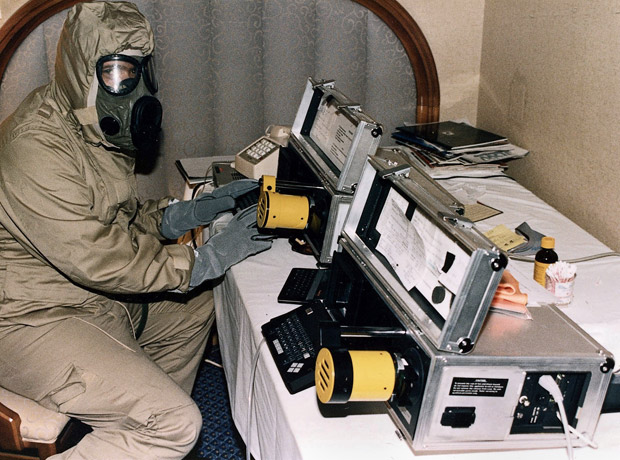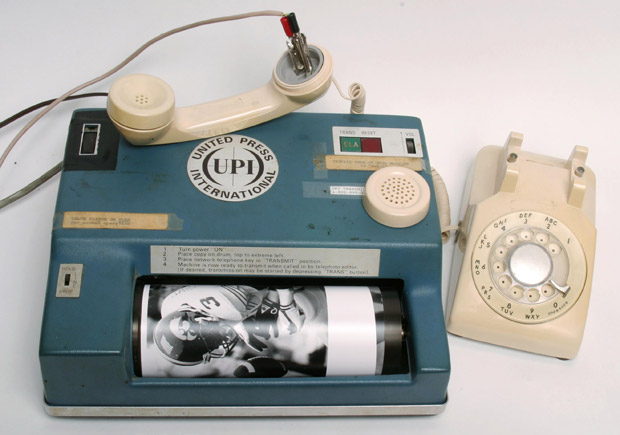Photojournalism as hard work

Chris Wilkins transmits a photograph using a Hasselblad Dixel digital transmitter during a rocket attack on Dharan (Saudi Arabia) on the first night of the Persian Gulf War, January 17, 1991.
The craft of a photojournalist in the middle and end of the 20th century required not only courage in the light of constant danger, the talent of a photographer, knowledge of news, politics, sports, the ability to think and take pictures on the go, it was also required to be an excellent editor, able to choose the best pictures for transmission to newspapers on other parts of the world, and, most importantly, needed a powerful back and arms.
Today we are already accustomed to the huge size of photo files and, thanks to the Internet, monstrously fast transfer speeds. To capture and deliver images to the other end of the world, a professional photographer needs a set of equipment that can fit in a backpack. However, the situation with the baggage of visiting photographers of an earlier era - some twenty years ago - was much less pleasant.
Chris Wilkins recallshow massive his exit set was: it consisted of five large rigid containers containing everything necessary for working in the development room and transmitting equipment. The first two containers contained equipment for processing the film and its drying, in the third there was equipment for printing enlarged samples for shipment. The fourth container contained a mechanical typewriter and sheets of sticky paper to create comments on photographs. And finally, the fifth box was packed with an analog photo transmitter for sending photos.
The weight of the whole set was several tens of kilograms, while there were no cameras or lenses - the photographer’s main armament.

This model of the black and white transmitter of the United Press UPI Model 16-S news agency was used until about 1991. The transmitter is connected to an old-style telephone in order to show how the transmission was carried out. The sample was placed on a drum and slowly scanned while the signal was transmitted over the telephone line. Transferring one image took 8-9 minutes.
The transmitter’s audio signal consisted of beeps, heating up the atmosphere of an already painful procedure, during which a photograph was wound onto a drum, and a laser beam read it. The perfect connection made it possible to transfer one color photo in 26 minutes, international sending required almost twice as much time, sometimes an hour per photo.

In 1988, France-Presse began using the Hasselblad Dixel, the first digital transmitter for 35 mm film. For the first time, the new device was tested at the Calgary Olympics, and the news agency gained a significant advantage over its competitors. Transferring a color photograph took two to three minutes, but the quality and clarity did not suffer. France-Press photographers have already relaxed, waiting for the end of the analog nightmare.
However, one of the drawbacks of the new machine was its extreme fragility, which did not interfere with working perfectly in an office environment; while traveling, computer boards and the optical scanning module were disconnected. I had to transport a tiny computer in a huge box with 30-cm foam armor.
Photographers of France-Presse soon became computer enthusiasts, and the frequent analysis of the new apparatus, its constant bringing to life contributed to this. Dixel was so unreliable that soon, as an understudy, sometimes it took old heavy and slow, but familiar equipment, and this again added kilos to the luggage.
 A year later, the Associated Press introduced Leafax, an independent scanner and transmitter. The first generation was analog, digital models later appeared.
A year later, the Associated Press introduced Leafax, an independent scanner and transmitter. The first generation was analog, digital models later appeared.Digital cameras appeared in 1994, and already in 1996 the film could be forgotten. At first, the cameras had something of the order of 1 megapixel, and the file sizes were also small, but manufacturers quickly began to improve the situation. Today, news agencies send files in dozens of megapixels with amazing quality, and it is impossible to distinguish film from a digital image. Even mobile phones have such good cameras that they are not neglected by professionals. And, fortunately, modern photojournalists are unlikely to again have to face the old clumsy and slow technology.
